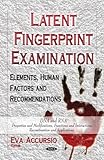Latent fingerprint examination : elements, human factors and recommendations / Eva Accursio, editor.
Contributor(s): Accursio, Eva [editor.]
Language: English Series: DNA and RNA-properties and modifications, functions and interactions, recombination and applications: Publisher: New York : Nova Science Publishers, Inc., [2014]Description: 1 online resourceContent type: text Media type: computer Carrier type: online resourceISBN: 9781631178924; 9781631178931Subject(s): Fingerprints -- IdentificationGenre/Form: Electronic books.DDC classification: 363.258 LOC classification: HV6074Online resources: Full text available at EBSCOhost Click here to view Summary: Fingerprints have provided a valuable method of personal identification in forensic science and criminal investigations for more than 100 years. Fingerprints left at crime scenes generally are latent prints—unintentional reproductions of the arrangement of ridges on the skin made by the transfer of materials (such as amino acids, proteins, polypeptides, and salts) to a surface. Palms and the soles of feet also have friction ridge skin that can leave latent prints. The examination of a latent print consists of a series of steps involving a comparison of the latent print to a known (or exemplar) print. Courts have accepted latent print evidence for the past century. However, several high-profile cases in the United States and abroad have highlighted the fact that human errors can occur, and litigation and expressions of concern over the evidentiary reliability of latent print examinations and other forensic identification procedures has increased in the last decade. This book discusses latent print examinations in detail, and provides methods to improving the practice through a systems approach.| Item type | Current location | Home library | Call number | Status | Date due | Barcode | Item holds |
|---|---|---|---|---|---|---|---|
 EBOOK
EBOOK
|
COLLEGE LIBRARY | COLLEGE LIBRARY | 363.258 (Browse shelf) | Available |
Includes bibliographical references and index.
Fingerprints have provided a valuable method of personal identification in forensic science and criminal investigations for more than 100 years. Fingerprints left at crime scenes generally are latent prints—unintentional reproductions of the arrangement of ridges on the skin made by the transfer of materials (such as amino acids, proteins, polypeptides, and salts) to a surface. Palms and the soles of feet also have friction ridge skin that can leave latent prints. The examination of a latent print consists of a series of steps involving a comparison of the latent print to a known (or exemplar) print. Courts have accepted latent print evidence for the past century. However, several high-profile cases in the United States and abroad have highlighted the fact that human errors can occur, and litigation and expressions of concern over the evidentiary reliability of latent print examinations and other forensic identification procedures has increased in the last decade. This book discusses latent print examinations in detail, and provides methods to improving the practice through a systems approach.
Description based on print version record and CIP data provided by publisher.

There are no comments for this item.